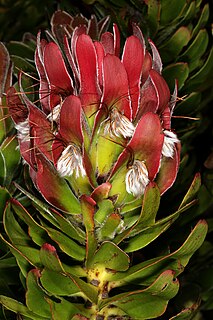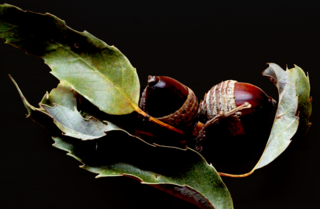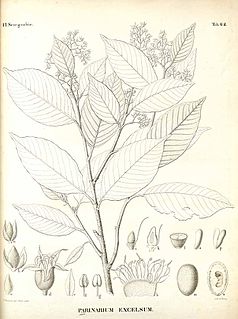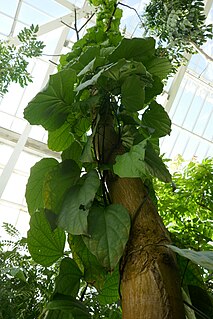
Trilepisium, the urnfigs or false-figs, is a small Afrotropical genus of plants in family Moraceae. They grow to medium-sized or large trees that occur in evergreen and semi-deciduous forests, flooded forests or forest patches and often along rivers and streams, and at altitudes of up to 2,000 m and over.

Leucospermum cordifolium is an upright, evergreen shrub of up to 1½ m (5 ft) high from the Proteaceae. The flower heads are globe-shape with a flattened top, 10–12 cm (3.9–4.7 in) in diameter, and are carried individually or with two or three together mostly at a right angle to its branch. The perianth is 3–3½ cm long, yellow, orange or crimson in color. From each flower emerges a 4½–6 cm (1.8–2.4 in) long style sticking out horizontally but curving upwards near the obliquely, shell-shaped, thicker pollen presenter. This gives each head the appearance of a pincushion. Its common name is ornamental pincushion in English and bobbejaanklou in Afrikaans. It flowers between the middle of July and the end of November. It naturally occurs near the south coast of the Western Cape province of South Africa. Varieties and hybrids of this species are used as cut flower and garden plant.

Rhodosphaera is a genus of plants in the family Anacardiaceae. The genus includes a single species, Rhodosphaera rhodanthema, which is a rainforest tree of eastern Australia. It grows in sub tropical rainforests and also in the drier form of rainforests. The natural range of distribution is from the Macleay River, New South Wales to Maryborough in south east Queensland. Common names include deep yellowwood, yellow cedar and tulip satinwood.

Mimetes fimbriifolius, also called cowl pagoda or the fringed pagoda, is a species of plant in the family Proteaceae. It is a dense, rounded, multi-branched tree that grows up to 4 metres in height. This attractive and striking plant flowers all year round, and produces red and yellow branch-heads and inflorescences. The nectar-rich flowers are pollinated by sunbirds and the seeds are distributed and taken underground by ants before germinating. It is endemic to the Table Mountain range in the city of Cape Town, South Africa.

Quercus stenophylloides, also called Arisan oak, is a species of evergreen, broad-leaf tree endemic to Taiwan.

Parinari excelsa, the Guinea plum, is a species of large, evergreen tree in the family Chrysobalanaceae. It has a very wide distribution in tropical Africa and South America. This species grows to 50 m (160 ft) tall while the trunk is up to 1.5 m (5 ft) in diameter.

Trilepisium madagascariense, the urnfig or false-fig, is a species of plant in the family Moraceae, with an extensive range in the subtropical and tropical Afrotropics. It grows to a medium-sized or large tree in primary or secondary forest, or in forest patches, and is rarely cultivated.

Cola nitida is a species of plant belonging to the family Malvaceae.
Rhopalocarpus mollis is a tree in the family Sphaerosepalaceae. It is endemic to Madagascar. The specific epithet mollis is from the Latin meaning "soft", referring to the very soft indumentum on the leaves' underside.

Leucospermum cuneiforme is an upright evergreen shrub with many pustules growing on the lower branches, wedge-shaped leaves, and oval, initially yellow flower heads that later turn orange, with long styles sticking far beyond the perianths, jointly giving the impression of a pincushion. It is called wart-stemmed pincushion in English and luisiesbos (lice-bush) in Afrikaans. The species is common in the southern mountains of South Africa.

Leucospermum formosum is a large upright shrub of up to 3 m (10 ft) high, from the family Proteaceae. It grows from a single trunk and its branches are greyish felty. The softly felty leaves are lance-shaped to elliptic, 6½–10 cm long and 14–20 mm (0.56–0.80 in) wide. The flower heads are flattened and about 15 cm (6 in) across, and consist of bright yellow flowers from which long, styles emerge which are strongly clockwise bent just below the white, later pink thickened tip. From above, the heads look like turning wheels. It is called silver-leaf wheel-pincushion in English. It flowers during September and October. It is an endemic species of the Western Cape province of South Africa.
Humbertia madagascariensis is a species of tree in the morning glory family, known in French as bois de fer; it is endemic to southeastern Madagascar where it occurs in humid evergreen forests at altitudes up to about 600 m (2,000 ft).

Lannea welwitschii is a species of tree in the family Anacardiaceae. It is native to the tropical rainforests of West and Central Africa. The timber is used to make furniture and utensils and for many other purposes, the fruits can be eaten, and the bark is used to produce a dye, for making rope and in traditional medicine.
Ludia mauritiana is a species of evergreen tree in the family Salicaceae. It is native to southeastern Africa and Madagascar. It was first described by the German botanist Johann Friedrich Gmelin, the type locality being Mauritius.
Gilbertiodendron dewevrei is a species of tree in the family Fabaceae, native to tropical rain forests in Central Africa. It is often the dominant tree species of the Guineo-Congolian rainforest. The timber is traded as limbali, and is used for construction, flooring and railway sleepers. It is also used for making boats, furniture, tool handles and joinery and for making charcoal.

Brachystegia laurentii, a legume in the family Fabaceae, is a species of large tree found in western Cameroon, Gabon, Equatorial Guinea, the Democratic Republic of the Congo and the Republic of the Congo. It has a dense, umbrella-shaped crown. The wood is known as bomanga and has many uses in building and construction.

Drypetes arguta, commonly known as the water ironplum, is a species of small tree or large bush in the family Putranjivaceae. It is native to tropical East Africa. It was first described in 1920 by the English botanist John Hutchinson, who named it Cyclostemon argutus. It was later transferred to the genus Drypetes.
Drypetes gerrardii is a species of small tree or large shrub in the family Putranjivaceae. Common names include forest ironplum, bastard white ironwood, and forest ironwood. It is native to tropical and subtropical central and eastern Africa. It was first described in 1920 by the English botanist John Hutchinson, who named it after the English botanist William Tyrer Gerrard who collected plants and seeds in southern Africa in the 1860s.
Guibourtia tessmannii is a species of legume in the family Fabaceae. It is a medium to large-sized tree and is native to Cameroon, Gabon and Equatorial Guinea. The timber has an attractive appearance and has many uses, and the bark is used in traditional medicine.

Couma utilis, called the milk tree, sorvinha, sorveira, sorva, and sorva-pequena, is a species of flowering plant in the subfamily Rauvolfioideae, native to the Orinoco and Amazon basins of South America. It is thought that C. utilis was on the verge of being domesticated by indigenous Amazonian peoples prior to the arrival of Europeans in the New World.












